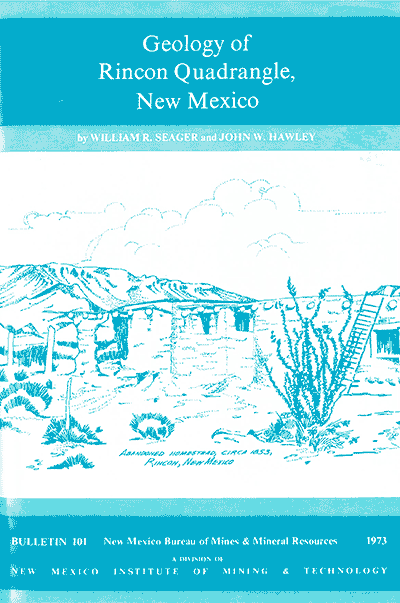
Bulletin 101—Geology of Rincon Quadrangle, New Mexico
By W. R. Seager and J. W. Hawley, 1973, 42 pp., 5 tables, 7 figs., 1 appendix, 1 index, 2 sheets.

Companion to Bulletins 97 and 100. Describes, in detail, Silurian to Holocene stratigraphy including development of Pleistocene geomorphic surfaces. The major structural features are fault systems associated with uplifts situated between the Rio Grande and Gramma grabens. Also discusses mineral deposits and ground water. The Rincon 7½-min quadrangle is located in north-central Doña Ana County, New Mexico, mostly north of the Rio Grande and the towns of Hatch and Rincon. Rocks and sediments in the quadrangle range in age from Silurian to Holocene.
Paleozoic rocks, deformed during the Laramide, form much of the southern Caballo Mountains. Fusselman Dolomite, Percha Shale, Caballero Formation, Lake Valley Formation, Magdalena Group, and San Andres Formation are well exposed. In the structurally lower Rincon Hills uplift, Paleozoic strata are overlain with angular unconformity by more than 7,000 ft of less-deformed Cenozoic volcanic and sedimentary rocks. These include in ascending order: fanglomeratic Love Ranch Formation, andesitic volcaniclastic Palm Park Formation, rhyolitic volcaniclastic strata and ash-flow tuffs of the Thurman Formation, including 400-ft thick tongue of Uvas Basaltic Andesite and Santa Fe Group. The Santa Fe Group is locally conformable with older rocks.
The Santa Fe Group comprises Bolson and valley-fill deposits subdivided into four formations. Fanglomeratic to basinal Bolson deposits of Miocene and Pliocene age comprise the basal unnamed transitional unit, Hayner ranch Formation, and Rincon Valley Formation. The Camp Rice Formation consists of deposits of the ancestral Rio Grande and adjacent piedmont slopes. The Camp Rice overlaps all older rock units with angular unconformity.
Middle to late Quaternary deposits are those of the present Rio Grande system. "Older" valley-fill alluvium, formed during middle to late Pleistocene cycles of valley cutting and backfilling, include arroyo terrace, fan, and rock-veneer deposits together with flood-plain and fluvial deposits and slope colluvium. "Younger" late Pleistocene to Holocene deposits are mainly those formed by the present cycle of cutting and backfilling by the Rio Grande and its tributaries. Major structural features in the quadrangle are high-angle normal faults of Miocene to Pleistocene age that border uplifts and adjacent grabens. Economic deposits in the area include: barite and manganese of Miocene age; clay, sand, and gravel of Pliocene to Holocene age; and ground water.
$7.00
Buy
Now
Also available as a free download.
Download
| File Name | Size | Last Modified |
|---|---|---|
| B101.pdf | 10.43 MB | 01/15/2021 10:53:50 AM |
| GISdata: | ||
| GeMSVariationRedaMe.txt | 1 KB | 07/31/2019 12:31:59 PM |
| Rincon.mpk | 3.98 MB | 07/22/2019 01:22:46 PM |



